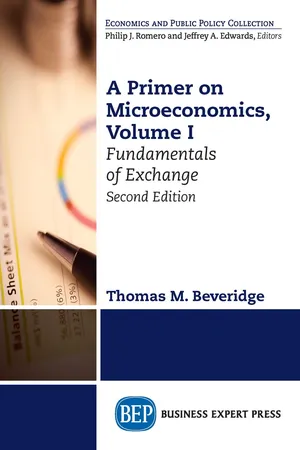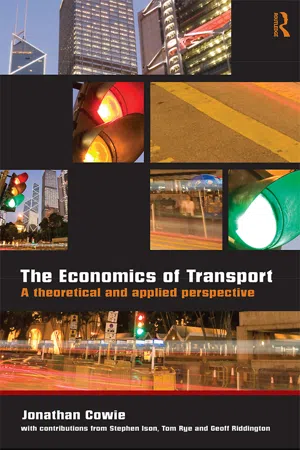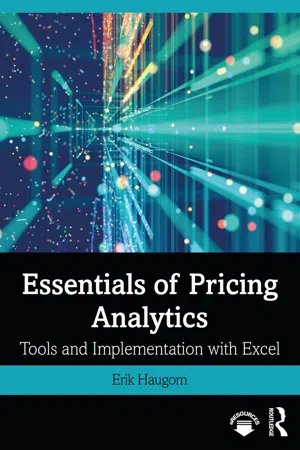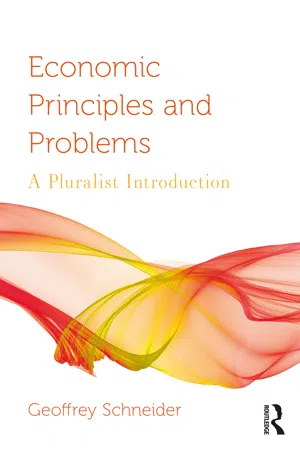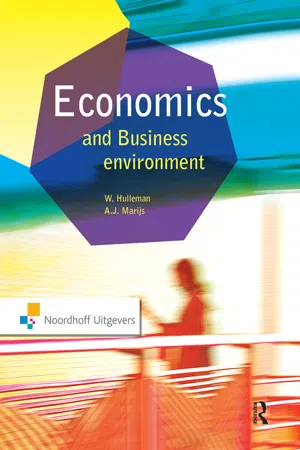Business
Own Price Elasticity Of Demand
Own Price Elasticity of Demand measures the responsiveness of the quantity demanded of a good to a change in its price, specifically from the perspective of the seller. It is calculated as the percentage change in quantity demanded divided by the percentage change in price. A high own price elasticity indicates that a small change in price leads to a large change in quantity demanded, and vice versa.
Written by Perlego with AI-assistance
Related key terms
9 Key excerpts on "Own Price Elasticity Of Demand"
- eBook - ePub
Microeconomic Principles and Problems
A Pluralist Introduction
- Geoffrey Schneider(Author)
- 2024(Publication Date)
- Routledge(Publisher)
Now that we have described how price floors, price ceilings, excise taxes, and per-unit subsidies affect the supply and demand model, we need to explore the topic of elasticity in more detail. Elasticity is an extremely useful concept for both consumers and producers to understand. It is particularly important for business owners trying to understand their consumer base and how they will respond to different pricing strategies.10.5 THE PRICE ELASTICITY OF DEMAND
Price elasticity of demand refers to the responsiveness of quantity demanded to changes in price. In mathematical terms, the price elasticity of demand, eD , is equal to the percentage change in the quantity demanded divided by the percentage change in price. The price elasticity of demand is less than or equal to zero, eD ≤ 0, because of the negative slope of the demand curve. In mathematical terms, the price elasticity of demand (eD ) can be written as follows:2e D==% ▵Q D% ▵ P=▵ QQ 1▵ PP 1(Q 2−Q 1)Q 1(P 2−P 1)P 110.5.1 Price inelastic demand
In general, a demand curve is said to be price inelastic if a change in price causes very little change in the quantity demanded. Inelastic demand curves tend to be steep. Notice that in the equation for the price elasticity of demand, if the percentage change in quantity is very small compared to the percentage change in price, we will get a fraction for eD because the numerator will be smaller than the denominator in absolute value. We use the absolute value to compare the magnitude of the change in price and the change in quantity demanded because one of the numbers will be negative given the negative slope of the demand curve. So, when the demand curve is price inelastic, the absolute value of the price elasticity of demand is between 0 and 1: 0 < |eD - eBook - ePub
- Andrew Barkley, Paul W. Barkley(Authors)
- 2016(Publication Date)
- Routledge(Publisher)
The elasticity of demand for narrowly defined goods is greater than for more broadly defined goods, since there are more substitutes available. For example, if the price of blue shirts (narrowly defined) increases, buyers will switch into green shirts, but if the price of all shirts (broadly defined) increases, consumers have few opportunities to purchase a less expensive shirt. Therefore, the elasticity of demand for blue shirts is greater than the elasticity of demand for all shirts.Next, we turn to calculation of demand elasticities.9.2.1 The own-price elasticity of demand
The definition of Own-Price Elasticity of Demand , also called the Elasticity of Demand , is:- Own-Price Elasticity of Demand = the percentage change in the quantity demanded in response to a percentage change in price.
(9.6) Ed = (ΔQd /Qd )/(ΔP/P) = (ΔQd /ΔP)*(P/Qd ).Economists calculate elasticities rather than slopes of demand functions because the slopes of curves are not directly comparable. Recall that it is not possible to graph variables measured in different units in the same quadrant. In Figure 9.7 , it appears that purchases of apples are more responsive to price changes than purchases of oranges. Actual calculations of the elasticities are necessary to show if this is the case. The reason is that the units of the graphs are different for apples and oranges.Box 9.2 Washington applesCurrently, the State of Washington has over 175,000 acres of irrigated apple orchards located on the Eastern Slope of the Cascade Mountains. The area produces 10 to 12 billion apples each year in orchards planted by the settlers as early as the 1820s. The rich soil from volcanic ash, plentiful sunshine, and arid climate provide excellent growing conditions for tree fruits such as apples and pears. The arid climate results in fewer insect and disease problems, making commercial apple production attractive. Today, the typical apple orchard is 50 acres, but some are as large as 3000 acres. An estimated 35,000 to 40,000 pickers work in the fields during the annual apple harvest. US consumers eat an average of 19 pounds of fresh apples each year, compared to about 46 pounds consumed each year by Europeans. More than half of the fresh crop of eating apples grown in the US is from the orchards in Washington State. - eBook - ePub
A Primer on Microeconomics, Second Edition, Volume I
Fundamentals of Exchange
- Thomas M. Beveridge(Author)
- 2018(Publication Date)
- Business Expert Press(Publisher)
Have you ever shopped around for the best price on airline tickets or hotel accommodation? Most of us have, and nowadays, the Internet helps us to do this with sites such as Travelocity and Expedia. But have you ever shopped around for the best price on electricity service for your home? Probably not, because for most of us, the electricity company we have is a “take it or leave it” situation and we have little flexibility, short of installing our own solar panels. In the case of airline tickets, we can be choosy and responsive to price differences, but in the case of electricity, we can’t. This brings us to a consideration of “elasticity.”Elasticity: A Measure of Responsiveness The Big Idea of ElasticityStudents of economics frequently complain that although there is a lot of theory, there are few practical numbers based on real-world experience. We know, for example, that an increase in price causes a decrease in quantity demanded, but we don’t know how much of a decrease there is. Is it a big decrease or a small decrease? Elasticity (a fancy word for “responsiveness” or “sensitivity”) answers this sort of a question. Price elasticity of demand measures how responsive or sensitive demanders are to a change in price—how much do they react to a price change? Income elasticity of demand measures how much demanders respond when income level changes—if there is a recession and income levels fall, how much will the demand for cars decrease? Cros s-price elasticity of demand measures how much the demand for one good changes when the price of a related good changes—if the price of Coca-Cola increases, how much does the demand for Pepsi increase? Price elasticity of supply measures how much the quantity supplied of a good will increase as its price rises—is it a large response (relatively “elastic”) or a small response (relatively “inelastic”)?In any elasticity calculation, we measure the extent of the change in one variable relative to the change in another variable. We could, for example, develop an “advertising elasticity of demand” to show how much the demand for our product changes as our advertising budget increases.Price Elasticity of DemandConsidering price elasticity of demand, we can establish an “intuitive” formula that will answer many of our questions quite simply. Price elasticity of demand (Ed ) measures how much quantity demanded (Qd - eBook - ePub
The Economics of Transport
A Theoretical and Applied Perspective
- Jonathan Cowie(Author)
- 2009(Publication Date)
- Routledge(Publisher)
In a more general sense, such an understanding of transport behaviour is important for any analyst of transport markets. Although most of the focus of demand elasticity tends to be on changes in the price, the idea of elasticity involves the responsiveness of the consumer to changes in any of the determinants of demand, not only the price. Hence the effect of changes in income are measured by income elasticity, cross price elasticity measures the effect of the change in the price of one mode on the demand for another, service elasticity the effect of improvements in the quality of service on demand and so on. A general definition therefore of elasticity of transport demand would be the responsiveness of demand for a transport mode to a change in one of its determinants.This chapter, under the title of transport demand elasticity, will further focus on the factors behind the demand for transport services by individual consumers before the following chapter provides further focus on supply in the form of the costs of providing transport services. Here the main types of elasticity will be outlined and some simplified elasticities calculated. The chapter also provides a practical perspective to the topic by giving an overview of some of the estimations that have been made of transport elasticities, and this will also help to reinforce many of the ideas presented in the chapter.PRICE ELASTICITY OF DEMAND FOR TRANSPORT SERVICES
Price elasticity of demand for transport services, as discussed previously, is the consumers’ demand responsiveness to changes in the price. This applies to all areas of transport, hence would refer to the operator’s price in the case of public transport, the supplier’s price in the case of freight carriage and the total price in the case of an individual’s private transport. Price elasticity is often referred to as ‘own’ price elasticity to draw a clear distinction from ‘cross’ price elasticity, which is the cross-over effect of price changes and will be examined later. In the face of price changes, the law of demand states that consumers (in total) will react by either consuming more in the case of price cuts or less in the case of price increases. As stated above, however, what is of more value is the extent to which consumers react to price changes, i.e. price elasticity. - eBook - ePub
Essentials of Pricing Analytics
Tools and Implementation with Excel
- Erik Haugom(Author)
- 2020(Publication Date)
- Routledge(Publisher)
elastic (right panel) demand curves, as usually presented in microeconomic texts. In this case, price is a function of demanded quantity. Both ways of illustrating the price elasticity of demand induce the same conclusion, though. For a price change of a given magnitude, the change in demand will be (relatively) high if demand is elastic and (relatively) low if demand is inelastic.Figure 5.2 Illustration of inelastic (left panel) and elastic (right panel) demand. In the upper panel demand is used on the Y-axis (as commonly done in price–response functions). The lower panel illustrates inelastic and elastic demand with price on the Y-axis (as commonly done in the economics literature).We now understand that the price elasticity of demand is determined by the steepness of the price–response function. This statement is a little too general, though. The reason is that for most functional forms of price–response functions, the estimate of the price elasticity will depend on what part of the curve we choose to use to calculate an elasticity estimate. To see this, consider the following expression that can be used to estimate the price elasticity of demand:ε =(5.2)(/ dd)(− dp 2)(p 1)(p 1)(/)p 2−p 1p 1This measure is known as the point elasticity of demand , although it requires two combinations of prices and quantities. This estimate will depend on both the old price(and the new pricep 1)(, and where we are on the price–response function (the general level of demand at the two prices). An example is given below.p 2)Example 5.1: Calculation of price elasticity of demand for a specific product.A company increased the price of one of its products from $59 to $64. As a result, the sales went down from 12,000 units to 11,300 units. What is the point elasticity in this case? - eBook - ePub
Microeconomics
A Global Text
- Judy Whitehead(Author)
- 2014(Publication Date)
- Routledge(Publisher)
P = 1 in absolute terms), the percentage change in the quantity demanded is exactly equal to the percentage change in price but in the opposite direction. Consequently, if price is reduced by a certain proportion (say 10 per cent), the quantity demanded is increased by the same proportion (10 per cent) and similarly for a price decrease. Consequently, neither a price increase nor a price decrease would affect the total expenditure on the product and so the seller’s revenue from the sale of the product remains unchanged with a change in price.The value of the price elasticity of demand depends on:- The availability of substitutes . Demand for a commodity is more price elastic where there are close substitutes.
- The extent to which the commodities may be characterized as luxuries or necessities . Luxury goods are more price elastic whereas necessities are more inelastic.
- Time period . Demand is more price elastic in the long-run than in the short-run.
- Alternative uses . The more alternative uses a commodity has, the greater the price elasticity of demand.
- The proportion of total income spent on the product . The greater the proportion the higher the elasticity.
Arc elasticity of demand
The above measures of price elasticity of demand refer to what may be called the point elasticity of demand. This is appropriate for small changes in price. For larger changes in price, the formula for arc price elasticity of demand is used. This may be expressed (with the subscript x omitted) as:3.2.2 The PCC and the price elasticity of demandPrice elasticity of demand may be determined from the shape of the price consumption curve (PCC ). As explained in Chapter 2 , the price consumption curve is the line joining successive equilibrium points as the price of good x falls. The price elasticity of demand can be derived from the price consumption curve using money and one good (x - Available until 20 Jul |Learn more
Contemporary Economics
An Applications Approach
- Robert Carbaugh(Author)
- 2016(Publication Date)
- Routledge(Publisher)
This is because price and quantity demanded are inversely related according to the law of demand. In our example, the increase in ticket prices causes the numerator in the formula to be positive (+10 percent), while the decrease in game attendance causes the denominator to be negative (−5 percent). As a result, E d will have a negative value. By convention, economists drop the negative sign when calculating the price elasticity of demand, realizing that price and quantity demanded move in opposite directions. Depending on the response of buyers to a change in price, demand is characterized as elastic, inelastic, or unit elastic. Elastic. Demand is elastic when the percentage change in quantity demanded is greater than the percentage change in price, meaning that E d is greater than 1. Example: A 20-percent reduction in the price of Pepsi causes a 30-percent increase in the quantity demanded. Specifically, E d is 1.5 in this case (30 / 20 = 1.5). Inelastic. Demand is inelastic when the percentage change in quantity demanded is less than the percentage change in price, meaning that E d is less than 1. Example: A 30-percent increase in the price of Levi’s jeans causes a 10-percent decrease in quantity demanded. Specifically, E d is 0.33 in this case (10 / 30 = 0.33). Unit elastic. Demand is unit elastic when the percentage change in quantity demanded equals the percentage change in price, meaning that E d equals 1.0. Example: An 8-percent decrease in the price of Timex watches causes an 8-percent increase in the quantity demanded (8 / 8 = 1.0). Table 3.1 reports the estimated price elasticities of demand for selected products. When making such estimates, economists distinguish between a period during which consumers have little time to adjust (the short run) and periods during which consumers have time to fully adjust to a price change (the long run) - eBook - ePub
Economic Principles and Problems
A Pluralist Introduction
- Geoffrey Schneider(Author)
- 2021(Publication Date)
- Routledge(Publisher)
SUVs ), giving SUVs a cross-price elasticity e SUVs-Gas = −0.3. Similarly, meat and potatoes are complements for many consumers, with a cross-price elasticity of −0.2.We also find goods that are neither substitutes nor complements for each other, in which case the cross-price elasticity is zero. The price of Coca-Cola has no impact on the demand for iPhones, so e Coke-iPhones = 0.Now that we have studied how elasticities affect the demand curve, we can move on to the price elasticity of supply, which helps us determine when supply curves are elastic or inelastic.10.8 Price elasticity of supply
The price elasticity of supply measures the responsiveness of quantity supplied to changes in price. In mathematical terms, the price elasticity of supply, e s , is equal to the percentage change in the quantity supplied divided by the percentage change in price. The price elasticity of supply is greater than or equal to 0, e s ≥0, because of the positive slope of the supply curve. The formula for the price elasticity of supply, e s , ise s==Δ QQ 1Δ PP 1.Q 2−Q 1Q 1P 2−P 1P 1The formula for the price elasticity of supply is the same as the formula for the price elasticity of demand, but we use two points along the supply curve to compute it. For example, in Figure 10.18 (a) we see an elastic supply curve for hamburgers. The supply of hamburgers is elastic because there is a large amount of frozen hamburgers available in storage, so suppliers can get more hamburgers very easily in the short run if demand increases. In Figure 10.18 (a), the demand for hamburgers increases, shifting to the right from D1 to D2 - eBook - ePub
- A. Marijs, W. Hulleman(Authors)
- 2019(Publication Date)
- Routledge(Publisher)
Elastic and inelastic demand may very well occur on the one market. Industries very often consist of a few very large enterprises and many small ones. If small companies raise their prices the customers will look for other suppliers and they will lose their market. Their demand curve is elastic. Large companies can sometimes raise prices without their customers looking for other suppliers. They control such a large part of the market that customers do not have an alternative. If they were to move to a competitor then that competitor would in turn see fit to raise prices. This is one of the reasons why companies try to increase their share of the market.Price elasticity of demand is important for turnover. Entrepreneurs can use price elasticity to determine the effects of a price change on turnover (the product of price and quantity). Entrepreneurs dealing with an inelastic demand will see their turnover increase with a price rise. A price rise of 1% that is accompanied by a drop in sales of less than 1% will result in a rise in turnover. The increase in turnover is roughly equivalent to the sum of the changes in price and quantity.In the elastic part of the curve, entrepreneurs can generate greater turnover by lowering the price.■ Example 2.1At a price of 100, the quantity (according to equation [1] ) is 400. The turnover is therefore 40 000. A price rise of 1% results in a drop in sales of 0.5%. The turnover increases from 40 000 to 40 198 (101 x 398). The turnover has risen by about 0.5% by a price rise of 1% and a sales drop of 0.5%.Test 2.8What will the change in turnover be if a price of 250 drops by 1%? Use equation [1] .Table 2.3 describes the relationship between the price elasticity of demand and turnover.Table 2.3 The relationship between price elasticity of demand and turnoverDemand elasticity Price Turnover −1 < Epq < 0 (inelastic demand) increase increase Epq < −1 (elastic demand) increase decrease A shift along and a shift of the demand curve
PositionChanges in the quantity demanded that are the result of a change in prices can be read from the demand curve. This is referred to as a shift along the curve. From equation [1] it is easily deduced that a price rise from 100 to 101 will result in a quantity change from 400 to 398. However the demand curve can change position as well: for example, because the needs have changed. If the need for a product increases, customers are prepared to buy a larger quantity at the same price. During a heatwave, the demand for soft drinks will increase, even though the price remains the same. In the graph this is indicated by a shift to the right of the curve. The demand function also changes. Because of the increasing need for a product the demand will increase at every price level. If at every price the demand increases by 50, equation [1]
Learn about this page
Index pages curate the most relevant extracts from our library of academic textbooks. They’ve been created using an in-house natural language model (NLM), each adding context and meaning to key research topics.


